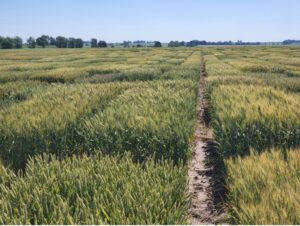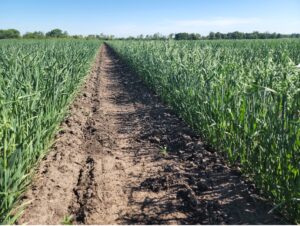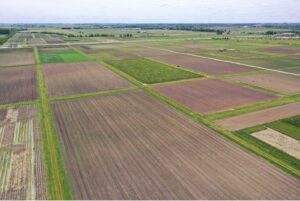Illinois Crops Update 6/10/2022
Each week, I put out a request to crops educators and specialists from the University of Illinois to compile an update to share with the entire state. We hope you find this information useful. If you have any questions or suggestions about the format or any feedback in general about these updates, please email me (harbach2@illinois.edu).
Aaron Hager, Extension Weeds Specialist, University of Illinois
Residual herbicides applied with postemergence soybean herbicides also can reduce the need for a second postemergence application. However, simply applying a soil-residual herbicide does not guarantee the product will provide the desired level or duration of weed control. Soil-residual herbicides applied with postemergence herbicides require precipitation to move them into the soil solution where they are available for uptake. Herbicide effectiveness is reduced when a soil-residual herbicide is sprayed on a dry soil surface with no precipitation for several days following application. Residual herbicides generally require 0.5 to 1.0 inch of precipitation within 7 to10 days after application for optimal incorporation. Also, keep in mind the labels of soil-residual products include a maximum soybean growth stage or time interval prior to harvest beyond which an application cannot be made.
Nick Seiter, Field Crop Insects Extension Specialist, University of Illinois
Nothing really unusual to report on the insect front this week, scattered problems with cutworms and armyworms. These are generally associated with either poor control of winter annuals (cutworms) or grassy weeds/cover crop (armyworm). Rootworm egg hatch is underway in central Illinois; anyone interested in adult sampling as part of our rootworm monitoring network should contact me at nseiter@illinois.edu.
Emerson Nafziger, Agronomy Extension Specialist (retired), University of Illinois
Planting progress for corn and soybean in Illinois has moved ahead of 5-year averages, but we should keep in mind that those averages include the very late planting of both crops in 2019. With the exception of a wet area in west-central Illinois and a dry area in east-central Illinois, most of the state has received normal to a slightly below-normal rainfall in June. June 5 crop condition ratings of 81 and 82% good + excellent for corn and soybeans, respectively, reflect good stands and little water damage with the dry conditions after planting. Small crop plants have not used very much water, so soil moisture is generally adequate, although corn plants growing in compacted soil may show leaf curling on hot afternoons that signals that root systems aren’t enlarging fast enough to maintain adequate water uptake. Soybeans have grown somewhat slowly so far, but high temperatures over the next week should speed things up. Soybean plants in most fields are not yet large enough (V3 stage) to flower, but with very warm temperatures next week, some may put on a few flowers before June 21. Lack of flowering by the summer solstice is not a concern: the large majority of flowers that set pods appear beginning in the first or second week of July, and rapid vegetative growth at that time will help the plant to set pods from those flowers.
Dennis Bowman, Digital Agriculture Extension Specialist, University of Illinois
Crops are currently in very good to excellent condition. Mid-week rains are maintaining conditions. Primary field activities were spraying and mowing. The University of Illinois Small Grains Field Day was postponed because of rain on June 8 and was held successfully on June 9th.





Phillip Alberti, Commercial Agriculture Extension Educator, Northern IL
Cooler temperatures and consistent, albeit moderate, accumulation events have slowed field operations in the last week in some areas of NW IL. With high temperatures and low chances of rainfall heading into and through next week, the moisture is welcome. Ample soil moisture will encourage positive growth as heat units rack up early in the season. Corn (~V2/V3) and soybean (~V1/V2) have benefited from the moisture, encouraging uniform germination and emergence. Overall, I like what I am seeing as we move through Stephenson and Winnebago counties. With the incoming heat units, I expect many fields to look a lot different this time next week.
Talon Becker, Commercial Agriculture Extension Educator, South Central IL
In south central Illinois, most farmers are nearing the end of the planting season. Dry weather last week as well as much of this week have allowed many farmers in the area to catch up with their neighbors to the north. Spotty showers did make their way through the region on Monday and Wednesday, and the forecast for Friday evening is showing similar chances for intermittent rain. However, the storm systems that made their way through earlier in the week were scattered and fast moving. At the Ewing Demonstration Center, we received 0.3″ so far this week. The forecast for next week looks to continue the dryer weather but add a whole lot of heat, with some highs in the upper 90s. That along with potential for a strong southern wind mid-week will likely dry things out a bit more and push wheat towards a slightly earlier harvest.
Nathan Johanning, Commercial Agriculture Extension Educator, Southwestern IL
The tail end of most of any spring planting is done and warm temperatures have the crops off to a good start. Only modest rain this past week of 0.55 inches total from two different storm systems. Wheat is starting to turn but no harvest has started yet.
Chelsea Harbach, Commercial Agriculture Extension Educator, Northwestern IL
There are very few fields left unplanted in the northwestern part of the state as of the end of this week. Crops that popped up a couple of weeks ago are looking great, with some later planted corn spiking through now. Post-plant herbicide and side-dress fertilizer applications are underway. Not much of concern at this point in the season from what I can see.






